How to transplant beets after thinning in the open field
Novice gardeners will find it helpful to learn how to thin out beets in order to get a good harvest of large and tasty root vegetables. This vegetable can be grown both in a seedless and seedling way. Therefore, the strong seedlings remaining after the breakthrough should not be thrown away - they can be used as seedlings. Most often, beets are planted after the first thinning, but if necessary, grown-up seedlings with 4-5 leaves can be used.
Features of sowing and growing beets
Beet seed germinate at a temperature of +4 ° C, but you should not rush to planting, since seedlings and grown plants do not tolerate frosts well. The vegetable shows the highest germination at +10 ° C. The seeding rate of seeds is 17-20 g per 10 m². Planting depth - 2.5-3 cm. With deep planting, germination decreases and the growth rate of the plant slows down due to lack of oxygen in the soil.
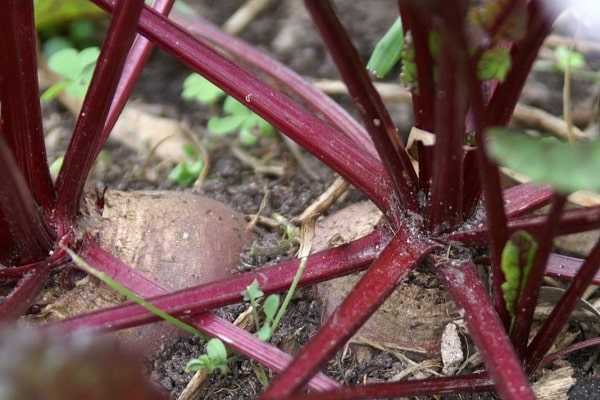
Beet seeds are infructescences or fruit aggregates, connected by 3-5 pieces into dense glomeruli. Each seed can give 2-4 full-fledged shoots, which leads to thickening of seedlings. If unnecessary shoots are not removed in time, the roots will grow small, deformed and tasteless. The seedlings remaining after thinning can be planted in free places.
If you want to get a harvest of large root crops, then you need to thin out the plantings at least twice. Moreover, the thinned distances should be 3-4 cm in the first procedure and 8-10 cm in the repeated breakthrough.

How to thin out beets?
Thinning is an important agricultural technique for all root crops, especially beets. You need to know how to properly break through plants. The size of the harvest will depend on the timeliness and quality of the procedure. To create the optimal feeding area for each plant, it is necessary to carry out 2-3, and sometimes 4 thinning of the seedlings.
As soon as the first permanent leaf appears, you can start thinning the plantings. Sometimes the first breakthrough has to be done at the cotyledon stage. Do not question the need for the procedure; friendly germination is, of course, good, but in thickened plantings the plants will oppress each other. It will not work to grow full-fledged root crops in such conditions.

It is advisable to thin out on a cloudy day or in the evening. The soil must be moist, so the day before the procedure, the plants are watered abundantly. Before thinning, the aisles are loosened. The strongest plant is left in each nest, and the rest are removed.
In order not to damage the desired seedlings, do not pull out the plants by the roots, it is better to pinch the sprout near the ground.For convenience, you can use tweezers or scissors. If after the breakthrough there are strong seedlings, then you should not throw them away. Beets can be transplanted into prepared furrows or where they have not sprouted.

Second procedure
Under favorable conditions, the plants grow well, as a rule, 2-3 weeks after the first breakthrough, the beets have time to grow 5-6 leaves, and the root crop reaches 3-4 cm in diameter. You can proceed with the second thinning procedure. Remove the largest plants that have reached tuft ripeness, as well as poorly developed specimens. The distance between the remaining plants should be at least 6-8 cm.

The third thinning is carried out when the roots reach 4-5 cm in diameter and they can already be used for food. At this time, the final stand density is formed. So that the root crop does not outgrow, the interval between plants after a breakthrough should be no more than 10-15 cm. A vegetable grower always has a choice - either to grow by seed, or to plant seedlings, so that later he does not have to thin out.
Subsequent breakthroughs are reusable selective harvesting.
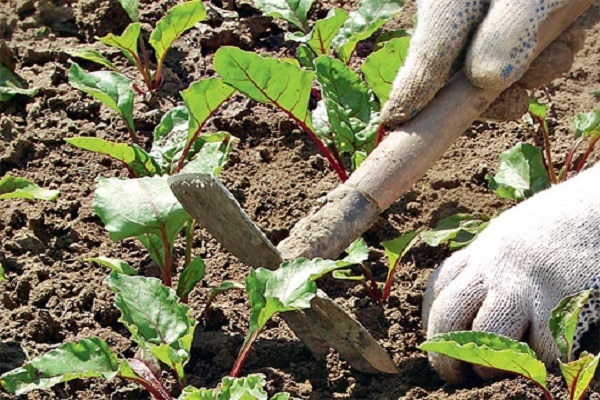
Transplanting beets during thinning
After the first thinning, there are many strong plants that can be used as seedlings. It is noticed that the planted beets take root well and form larger root crops than those planted with seeds in a permanent place.
If there are no additional beds for planting plants, you can find a place for seedlings between cucumbers, bell peppers, dill, and other vegetables (except beans). You can also root root seedlings on the sides of your strawberry beds. These plants get along well with each other.
It is advisable to transplant beets during thinning in rainy, cloudy weather, which will ensure better survival. The vegetable reacts very sensitively even to minor damage to the root, so you need to remove it from the ground using a narrow garden shovel. Then carefully place it in the prepared hole, avoiding bends and creases, otherwise the root crop will grow deformed.

If the root is too long, it is best to shorten it by one third. Before planting, you can dip the roots of the seedlings in a mixture of mullein and clay for good survival. In grown seedlings, all foliage is removed, leaving one central sprout. After transplanting, it is advisable to shade the plants by sticking small branches of a maple or other tree with large foliage next to them.
Many experienced vegetable growers do not recognize sowing beets immediately to a permanent place, but plant them only in seedlings. The advantage of this method lies in the absence of the need for thinning and in obtaining large root crops.

How to plant beets so as not to thin out?
To get a fruitful and sweet root crop, thinning beets in the open field is carried out 2 or even 3 times per season. If it is not possible to engage in plant breakthrough, you can immediately plant seedlings at a distance of 7-10 cm from each other. The seeds of beets are large, so this is not so difficult to do.
Many gardeners place beet seeds in advance on paper tapes coated with paste. During planting, the tapes are embedded in the furrows to a depth of no more than 2-3 cm and lightly sprinkled with earth. The disadvantage of this method is that some of the seeds may die, and the seedlings will be uneven. Therefore, in stock it is necessary to have a small area of plants for seedlings, so that there is something to replace the dead seedlings.
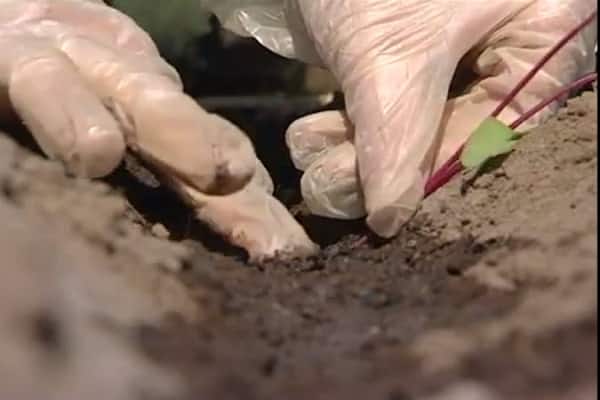
Tips from a seasoned gardener
Beets are demanding on soil fertility and do not tolerate shading well.There are a number of conditions on the fulfillment of which the quality of the crop will depend, so it will be useful to listen to the simple recommendations of experienced gardeners:
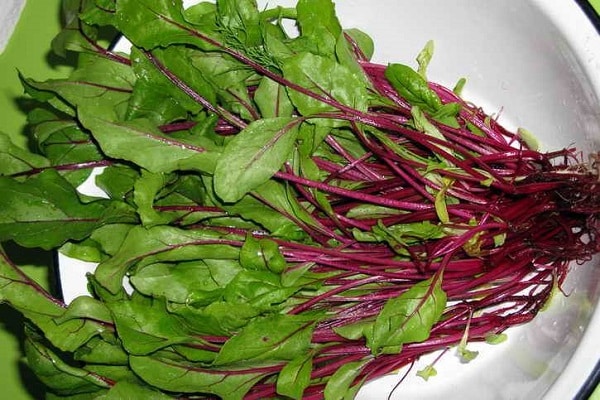
- If you want to get a good harvest of large root crops, then you need to grow on your site only zoned varieties of domestic selection.
- Before sowing, you need to process the beet seeds in a weak solution of manganese or ash (2 tablespoons per 1 liter of water). Then wrap in a damp cloth and put in a warm place until the sprouts are pecked.
- Too large root crops are poorly stored, accumulate more nitrates, and often have poor taste. To get medium-sized lying beets, it is necessary to reduce the distance between rows to 18-20 cm, and in rows to 8-10 cm.
- Experienced gardeners do not want to waste time fighting thickened beet shoots, it is much easier to grow high-quality root crops with seedlings.
- Beets do not develop well on acidic soils, so it will be useful to water them with ash water twice a season (1 glass of ash per bucket of water). You can dust the aisles with dry ash (followed by loosening the soil).
- Wood ash is also a good pest repellant.
- To increase the sugar content, beets are watered twice a season with slightly salted water (1 tbsp. L. Salt without top per 1 liter of water). The first watering is carried out during the period of tying the root crop, the second - a month before harvesting.
Even a novice summer resident can grow an unpretentious and tasty root crop. Applying in practice the useful advice of experienced gardeners, you can get a significant increase in the yield.
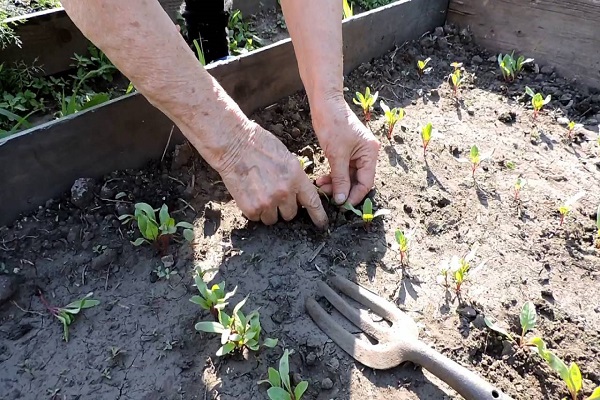



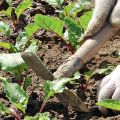
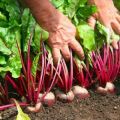
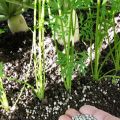
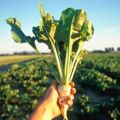


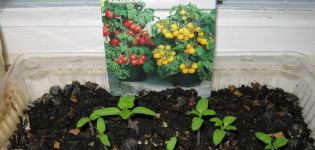
Beets recover remarkably well, so there should be no problems with their transplantation. After this procedure, the root crop requires fertilizers, I recommend using the bioactivator "BioGrow».